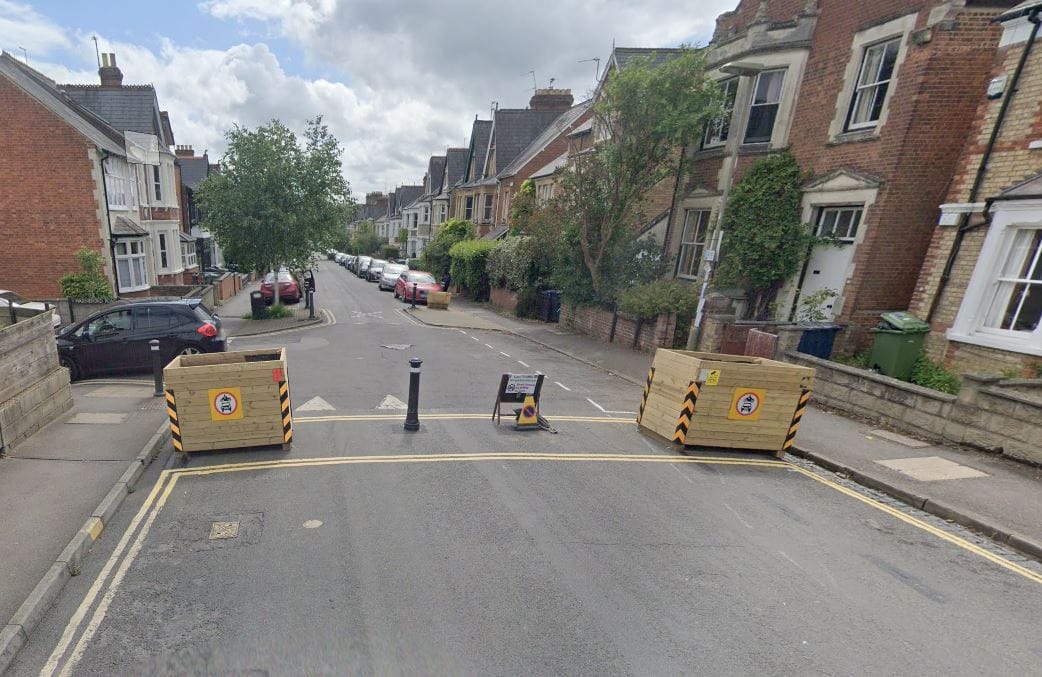East Oxford low-traffic neighbourhoods: here to stay, but less safe

On 17 October the County Council decided to:
- make the East Oxford LTNs permanent (following an 18-month experimental period)
- remove bollards and replace them with ANPR cameras on Divinity Road, Magdalen Road and James Street
- allow taxis, emergency service vehicles and Royal Mail vehicles through those ANPR camera points
HLS delivered a speech at the meeting in favour of making the LTNs permanent but opposing replacing bollards with ANPR cameras, which can be viewed here. See the recording of the Cabinet meeting and the County Council's news items
The Council is planning to replace the bollards with ANPR cameras in the Cowley and East Oxford LTNs in April 2024.
Good news and bad news
We are obviously very relieved that the East Oxford LTNs have been made permanent, but are seriously concerned about the decisions to remove bollards and allow taxis and other vehicles through, just as the Council chose to do in the Cowley LTNs (see our previous post Low traffic neighbourhoods at risk from council decision).
From the Headington perspective, Cheney School pupils are some of the biggest beneficiaries of the East Oxford low-traffic neighbourhoods: the bollards and planters used to create access-only, low-traffic roads around Divinity Road and the roads off Cowley Road have created invaluable safe walking and cycling routes for children who live in East Oxford to get to and from Cheney School.
A major concern is that these decisions, which will enable significant numbers of both exempted and non-exempted/illegal vehicles to use these roads as quick cut-through routes once again, pose an unreasonable and unjustifiable risk to the safety of children and other vulnerable road users, including, in particular, Cheney School pupils – with Divinity Road and Magdalen Road being key safe cycling routes to Cheney School.

Learnings from the Windmill School Street
Several of us in Headington Liveable Streets were involved in the Windmill School Street scheme as parents and stewards. We’ve seen how switching from physical barriers to ANPR has reduced safety and fundamentally undermined the School Street.
Since it changed to ANPR, numerous cars, taxis, vans and even lorries drive through. The area outside the school is no longer a safe space. Where before, children and their families could use the whole space to walk, cycle and scoot safely, cross the road easily and play and talk with friends, they now cling to the pavements as motor traffic once again dominates the space.
This experience, together with information obtained from FOI requests, has shown that ANPR cameras aren’t effective in creating safe streets and that there are serious problems regarding the monitoring and enforcement of traffic volumes and contraventions through ANPR-enforced filter points.
We fear that the Windmill School Street serves as a stark warning of what’s to come on ANPR-controlled LTN streets, yet the Cabinet member for Highways dismissed this experience and data as irrelevant to the LTN decision.
Magdalen College School wants the East Oxford LTNs to be removed
Magdalen College School used their speech at the Cabinet meeting to call for the East Oxford LTNs to be removed. (See the MCS Bursar’s speech on the recording of the Cabinet meeting at around 0:21:28.)
Many people were appalled by the Bursar’s speech, in which she identified Divinity Road and Howard Street as “key cross-town routes” that MCS parents want to be able to drive through. This was essentially a demand to destroy safe walking and cycling routes to Cheney School and many other local state primary, secondary and nursery schools, to enable privileged private school pupils to be driven to school faster.
The irony that MCS parents are responsible for a significant amount of the problematic congestion and road danger on The Plain and surrounding roads in East Oxford of which she complained in her speech was apparently lost on her, although glaringly obvious to most people listening.
Luckily, MCS didn’t get their way in getting the LTNs removed; but unfortunately, the Council’s decision to replace bollards with ANPR cameras on Divinity Road, Magdalen Road and James Street may enable MCS and other private school parents to use these roads once again as convenient rat runs, being able to afford to pay Penalty Charge Notices and take advantage of lax ANPR enforcement.
No effective measures being taken to reduce congestion
The Council clearly has ANPR cameras available to manage traffic, so why didn’t the Council choose to use them to reduce traffic on the main roads instead of weakening the LTNs?
It is congestion that is causing all the problems and the stated reasons for opposition regarding the LTNs: delayed bus services, delayed emergency response times, delayed taxi trips to the hospitals, pollution.
The reason this congestion still exists is because the Traffic Filters scheme, which is designed to remove this congestion, has been delayed as a result of the closure of Botley Road due to Network Rail’s rebuilding of the railway bridge.
No explanation has been given as to why the Council can’t bring forward the East Oxford traffic filters (St. Clement’s Street and St. Cross Road being the priority filters, but Marston Ferry Road and Hollow Way would also help).
And even if there is a good reason why this can’t happen, why not use the cameras to implement main road traffic reduction measures as emergency, temporary solutions until the Traffic Filters scheme can be implemented, such as bus gates on:
- St Clement’s Street
- Morrell Avenue (as suggested by the Morrell Avenue Area Residents Association)
- Magdalen Bridge/Longwall Street
- Cowley Road (as planned by the Council and funded under the 2nd Active Travel Funding tranche in 2021)
It seems odd that these options weren’t even acknowledged in the Officer’s report or any Cabinet members’ speeches – a very big elephant in the room.
To stop the problems caused by too much traffic on the main roads in East Oxford, surely the rational and just option is to restrict the problem-causing traffic on the main roads, not destroy the safe roads that bollard-protected LTNs have created?
Replacing LTN bollards with ANPR won’t improve bus service times. Nothing will change, except that the most vulnerable and voiceless people will lose the safe streets we’ve been fighting for for decades.
Where are the risk assessments?
Replacing LTN bollards with ANPR cameras will introduce risks caused by both exempted vehicles (taxis, emergency service vehicles, Royal Mail vans) and non-exempted/illegal vehicles being driven through the LTNs.
Yet there were no risk assessments in the Officer’s report addressing either the physical safety risks to vulnerable road users such as:
- pedestrians
- cyclists
- wheelchair and mobility scooter users
- children
- people with limited mobility or impaired vision or hearing
or the risk of harassment, victimisation and inequitable access for people with protected characteristics such as:
- children
- the elderly
- women
- disabled people
likely to be caused by these vehicles and their drivers once bollards are removed.
These risks seem obvious, so why was no such Risk Assessment or Equalities Impact Assessment carried out?
Further attempts from the Conservatives and Labour to destroy the LTNs
Since the decision on 17 October to make the East Oxford LTNs permanent, there have been two attempts to remove some or all of the Cowley and East Oxford LTNs:
Attempt #1
The first attempt was from Conservative Councillor Liam Walker (Hanborough & Minster Lovell) via a motion at a Council meeting on 7 November to remove the Cowley and East Oxford LTNs. Labour Councillors Duncan Enright and Charlie Hicks proposed an amendment to the motion, and the amended motion was agreed at that meeting, so the following amendment ended up being passed:
“Oxfordshire County Council no longer has support for notes the opposition to the
- i. Cowley LTN scheme; and
- ii. East Oxford LTN scheme.
Council now requests Cabinet to urgently consider setting in train the necessary executive steps to remove the congestion around the Cowley LTNs as agreed by the Cabinet Member for Environment (including Transport) on 21st January 2021 and the East Oxford LTNs as agreed by Cabinet on Tuesday 17th October 2023.”
Although the Labour amendment took the sting out of the Conservative motion, we were quite alarmed and disappointed by the speeches from Labour Councillors Liz Brighouse (Churchill and Lye Valley) and Duncan Enright (Witney North and East) indicating willingness to further weaken the LTNs by removing filters and allowing more exemptions. And Councillor Walker reported in his speech that Labour Councillor Glynis Phillips (Barton, Sandhills & Risinghurst) had said that the East Oxford LTNs should not be made permanent.
See the recording of the Council meeting (public addresses at 0:17:30; councillor addresses at 5:16:25; Brighouse 5:24:35; Enright 5:30:12; Walker 5:27:50) and BBC article Oxford LTNs: Conservative motion to remove LTNs fails for further detail.
Attempt #2
The second attempt was from Labour Councillor Michael O’Connor (University Parks), who brought the following motion to a Council meeting on 12 December:
“This Council notes:
- It was recorded in 2013 that ‘operational capacity has already been reached or exceeded on much of [Oxford’s] road network.’ Most of Oxford’s busiest roads have since seen significant further rises in motor traffic.
- The Council has not effectively engaged Oxford’s communities on transport. Too many feel their communities have been divided, their voices not heard, and concerns ignored.
- The evaluation report for the East Oxford LTNs notes that there have been ‘large increases in traffic near The Plain roundabout’ as traffic is funnelled down three radial routes.
- Now is the time for pragmatic and fair solutions to long-standing congestion problems, including those exacerbated by LTNs, and for listening to all our residents, building on the motion unanimously passed by Council on 7 November.
Council urgently requests Cabinet to:
- Investigate opening a direct route for motor traffic between Iffley Road, Cowley Road and St. Clement’s, such as Rectory Road and Marston Street, to facilitate traffic dispersion.
- Investigate installing traffic lights on The Plain to improve traffic flow.
- Investigate measures to reduce private school traffic on The Plain, such as a school street on Cowley Place.
- Investigate opening the Littlemore Road filter to motor traffic outside school travel hours and provide traffic calming, segregated cycle lane, and pick-me-up service to key amenities.
- Create a taskforce to work with local communities and councillors to make other targeted, meaningful improvements to tackle congestion.
- Bring proposals to Cabinet within three months.”
The flaws in this motion have already been expertly picked apart in these X threads:
The motion was debated at the meeting, but there wasn’t enough time to vote on it. It may be resurrected at a future Council meeting; we hope it won’t be.
Both of these motions amount to unnecessary politicking and culture war-stoking and an egregious waste of everyone’s time, and most importantly prevented much more important Council business, such as SEND provision, being dealt with as two Council meetings were yet again dominated by debates over traffic reduction measures.
It is disappointing to say the least to see Labour trying to destroy safe streets in East Oxford, whereas it’s to be expected from the Conservatives. We didn’t think Labour would take it upon themselves to push forward Rishi Sunak’s ‘Plan for Motorists’ in Oxford.
Let’s take the win
The outcome isn’t ideal, but making the East Oxford LTNs permanent is at least a partial victory.
The Council has taken a courageous and nationally significant step to keep the Cowley and East Oxford LTNs in the face of both local opposition and even international conspiracy theories focussed on these few square miles of land in Oxford.
Use of ANPR in LTNs is likely to be a disaster – the affected roads will be less safe but the congestion on the boundary roads will stubbornly persist, and the results will speak for themselves. Hopefully people will realise that the only way to stop the problems caused by traffic is to remove the problem traffic.
It just seems incredibly unfair that children and other vulnerable road users will have their safety and independence taken away for however many months these roads will be unprotected, effectively functioning as unwilling risk assessment indicators.
